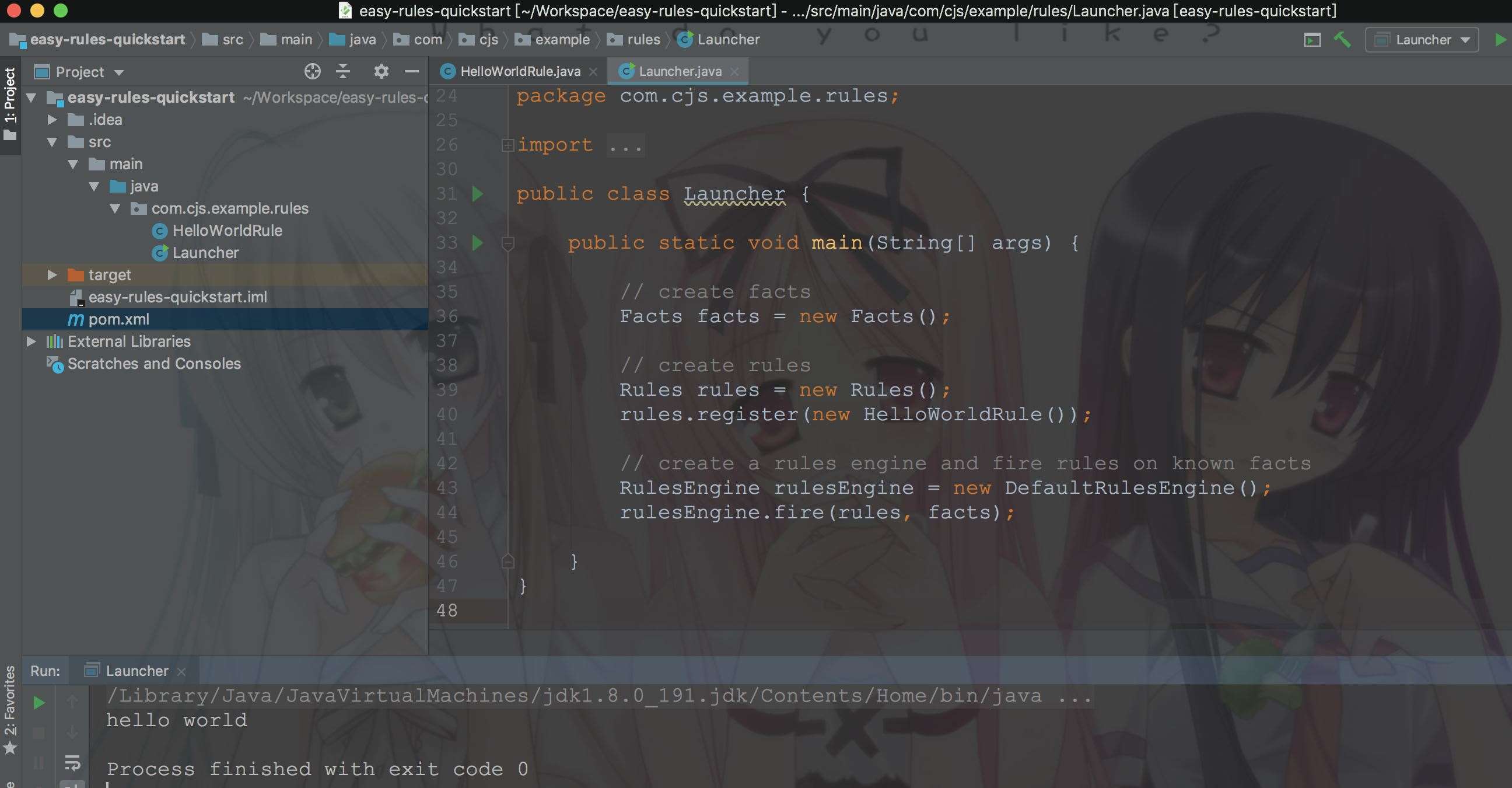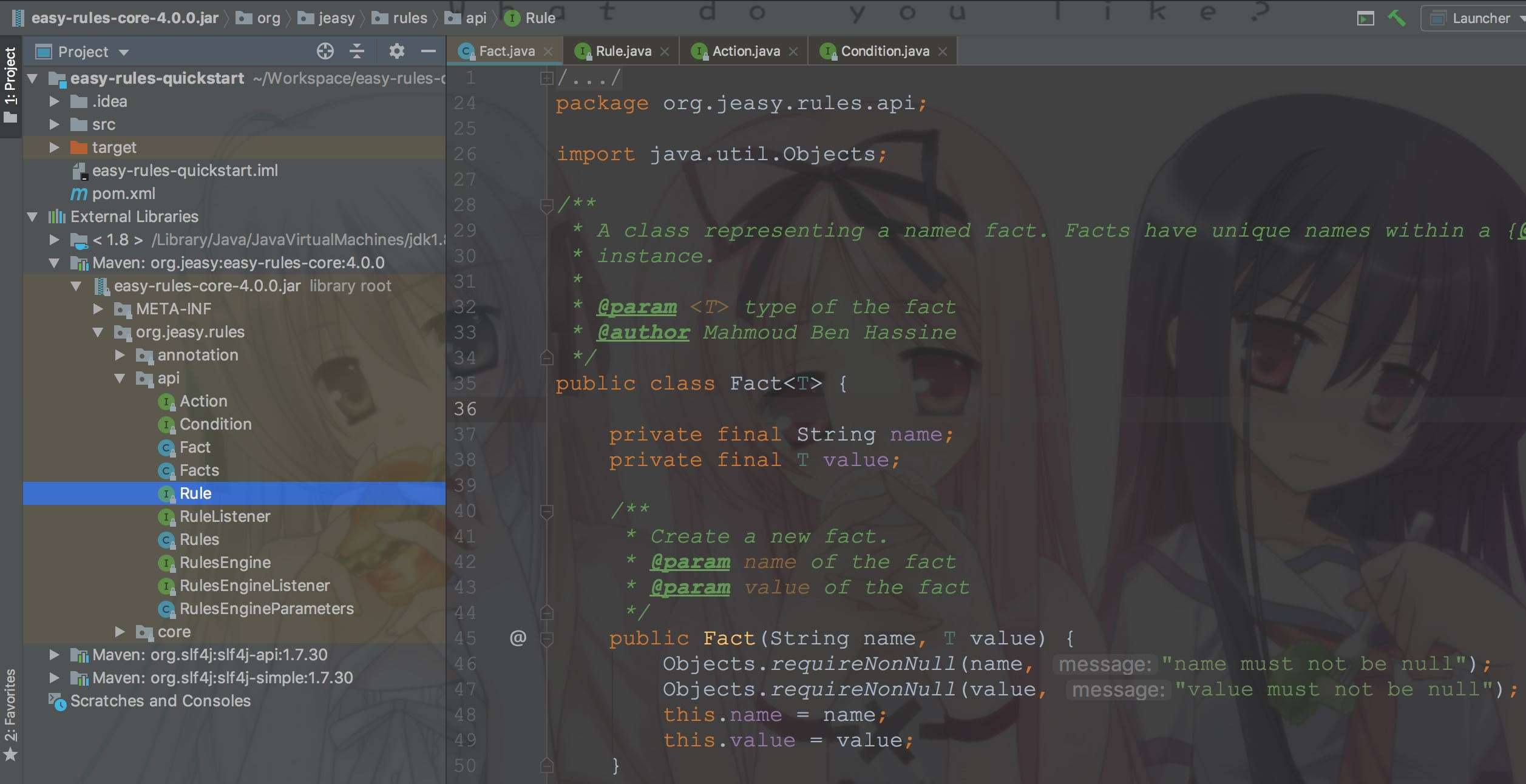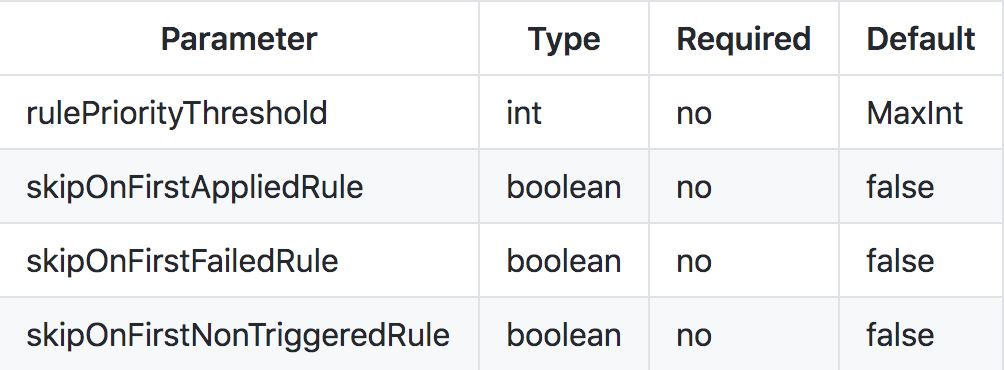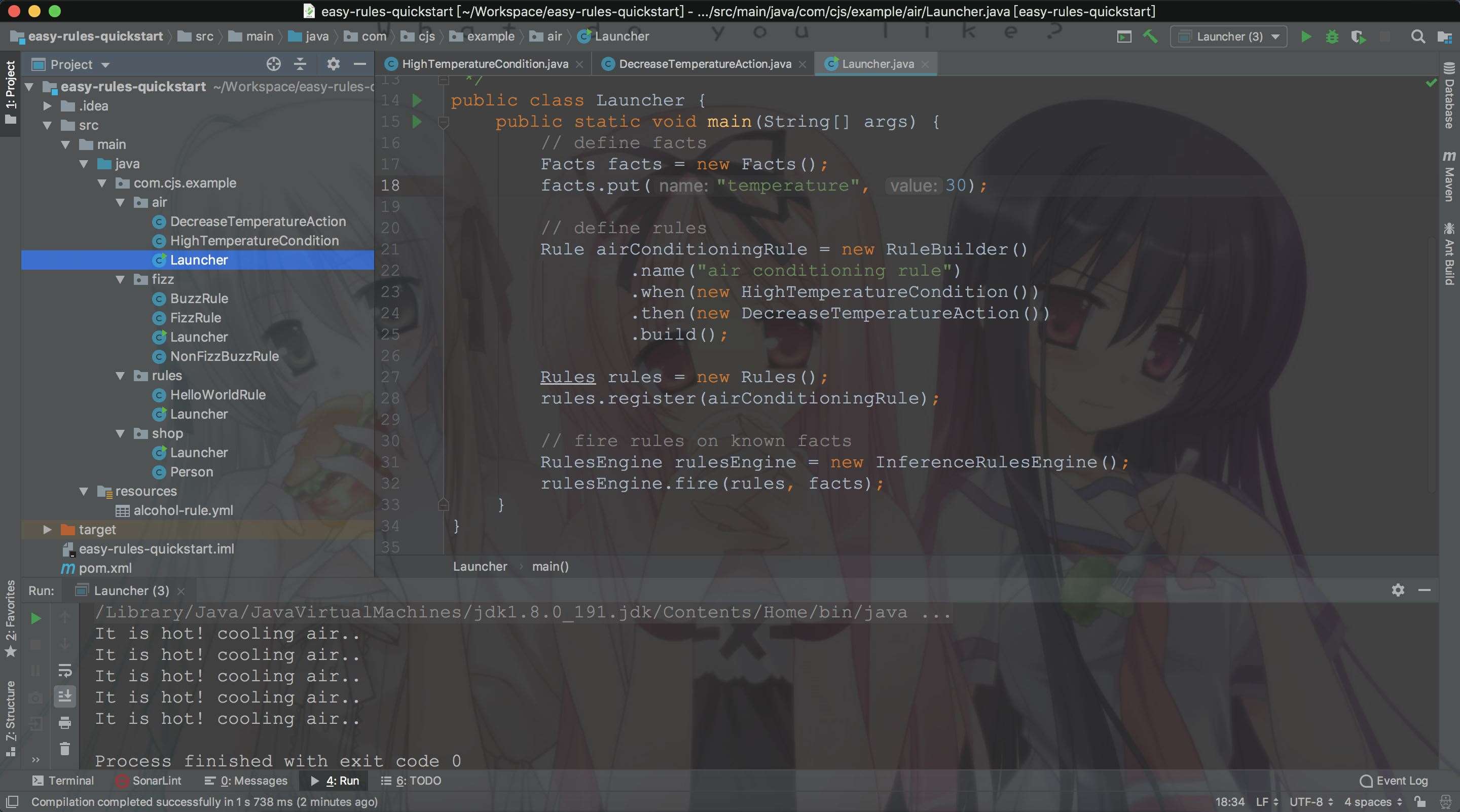Java規則引擎Easy Rules的使用介紹
1. Easy Rules 概述
Easy Rules是一個Java規則引擎,靈感來自一篇名為《Should I use a Rules Engine?》的文章
規則引擎就是提供一種可選的計算模型。與通常的命令式模型(由帶有條件和循環的命令依次組成)不同,規則引擎基于生產規則系統。這是一組生產規則,每條規則都有一個條件(condition)和一個動作(action)———— 簡單地說,可以將其看作是一組if-then語句。
精妙之處在于規則可以按任何順序編寫,引擎會決定何時使用對順序有意義的任何方式來計算它們。考慮它的一個好方法是系統運行所有規則,選擇條件成立的規則,然后執行相應的操作。這樣做的好處是,很多問題都很自然地符合這個模型:
if car.owner.hasCellPhone then premium += 100;if car.model.theftRating > 4 then premium += 200;if car.owner.livesInDodgyArea && car.model.theftRating > 2 then premium += 300;
規則引擎是一種工具,它使得這種計算模型編程變得更容易。它可能是一個完整的開發環境,或者一個可以在傳統平臺上工作的框架。生產規則計算模型最適合僅解決一部分計算問題,因此規則引擎可以更好地嵌入到較大的系統中。
你可以自己構建一個簡單的規則引擎。你所需要做的就是創建一組帶有條件和動作的對象,將它們存儲在一個集合中,然后遍歷它們以評估條件并執行這些動作。
Easy Rules它提供Rule抽象以創建具有條件和動作的規則,并提供RuleEngine API,該API通過一組規則運行以評估條件并執行動作。
Easy Rules簡單易用,只需兩步:
首先,定義規則,方式有很多種
方式一:注解
@Rule(name = 'weather rule', description = 'if it rains then take an umbrella')public class WeatherRule { @Condition public boolean itRains(@Fact('rain') boolean rain) { return rain; } @Action public void takeAnUmbrella() { System.out.println('It rains, take an umbrella!'); }}
方式二:鏈式編程
Rule weatherRule = new RuleBuilder() .name('weather rule') .description('if it rains then take an umbrella') .when(facts -> facts.get('rain').equals(true)) .then(facts -> System.out.println('It rains, take an umbrella!')) .build();
方式三:表達式
Rule weatherRule = new MVELRule() .name('weather rule') .description('if it rains then take an umbrella') .when('rain == true') .then('System.out.println('It rains, take an umbrella!');');
方式四:yml配置文件
例如:weather-rule.yml
name: 'weather rule'description: 'if it rains then take an umbrella'condition: 'rain == true'actions: - 'System.out.println('It rains, take an umbrella!');'
MVELRuleFactory ruleFactory = new MVELRuleFactory(new YamlRuleDefinitionReader());Rule weatherRule = ruleFactory.createRule(new FileReader('weather-rule.yml'));
接下來,應用規則
public class Test { public static void main(String[] args) { // define facts Facts facts = new Facts(); facts.put('rain', true); // define rules Rule weatherRule = ... Rules rules = new Rules(); rules.register(weatherRule); // fire rules on known facts RulesEngine rulesEngine = new DefaultRulesEngine(); rulesEngine.fire(rules, facts); }}
入門案例:Hello Easy Rules
<dependency> <groupId>org.jeasy</groupId> <artifactId>easy-rules-core</artifactId> <version>4.0.0</version></dependency>
通過骨架創建maven項目:
mvn archetype:generate -DarchetypeGroupId=org.jeasy -DarchetypeArtifactId=easy-rules-archetype -DarchetypeVersion=4.0.0
默認給我們生成了一個HelloWorldRule規則,如下:
package com.cjs.example.rules;import org.jeasy.rules.annotation.Action;import org.jeasy.rules.annotation.Condition;import org.jeasy.rules.annotation.Rule;@Rule(name = 'Hello World rule', description = 'Always say hello world')public class HelloWorldRule { @Condition public boolean when() { return true; } @Action public void then() throws Exception { System.out.println('hello world'); }}

2. 規則定義
2.1. 定義規則
大多數業務規則可以用以下定義表示:
Name : 一個命名空間下的唯一的規則名稱 Description : 規則的簡要描述 Priority : 相對于其他規則的優先級 Facts : 事實,可立即為要處理的數據 Conditions : 為了應用規則而必須滿足的一組條件 Actions : 當條件滿足時執行的一組動作Easy Rules為每個關鍵點提供了一個抽象來定義業務規則。
在Easy Rules中,Rule接口代表規則
public interface Rule { /** * This method encapsulates the rule’s conditions. * @return true if the rule should be applied given the provided facts, false otherwise */ boolean evaluate(Facts facts); /** * This method encapsulates the rule’s actions. * @throws Exception if an error occurs during actions performing */ void execute(Facts facts) throws Exception; //Getters and setters for rule name, description and priority omitted.}
evaluate方法封裝了必須計算結果為TRUE才能觸發規則的條件。execute方法封裝了在滿足規則條件時應該執行的動作。條件和操作由Condition和Action接口表示。
定義規則有兩種方式:
通過在POJO類上添加注解 通過RuleBuilder API編程可以在一個POJO類上添加@Rule注解,例如:
@Rule(name = 'my rule', description = 'my rule description', priority = 1)public class MyRule { @Condition public boolean when(@Fact('fact') fact) { //my rule conditions return true; } @Action(order = 1) public void then(Facts facts) throws Exception { //my actions } @Action(order = 2) public void finally() throws Exception { //my final actions }}
@Condition注解指定規則條件@Fact注解指定參數@Action注解指定規則執行的動作
RuleBuilder支持鏈式風格定義規則,例如:
Rule rule = new RuleBuilder().name('myRule').description('myRuleDescription').priority(3).when(condition).then(action1).then(action2).build();
組合規則
CompositeRule由一組規則組成。這是一個典型地組合設計模式的實現。
組合規則是一個抽象概念,因為可以以不同方式觸發組合規則。
Easy Rules自帶三種CompositeRule實現:
UnitRuleGroup : 要么應用所有規則,要么不應用任何規則(AND邏輯) ActivationRuleGroup : 它觸發第一個適用規則,并忽略組中的其他規則(XOR邏輯) ConditionalRuleGroup : 如果具有最高優先級的規則計算結果為true,則觸發其余規則復合規則可以從基本規則創建并注冊為常規規則:
//Create a composite rule from two primitive rulesUnitRuleGroup myUnitRuleGroup = new UnitRuleGroup('myUnitRuleGroup', 'unit of myRule1 and myRule2');myUnitRuleGroup.addRule(myRule1);myUnitRuleGroup.addRule(myRule2);//Register the composite rule as a regular ruleRules rules = new Rules();rules.register(myUnitRuleGroup);RulesEngine rulesEngine = new DefaultRulesEngine();rulesEngine.fire(rules, someFacts);
每個規則都有優先級。它代表觸發注冊規則的默認順序。默認情況下,較低的值表示較高的優先級。可以重寫compareTo方法以提供自定義優先級策略。
2.2. 定義事實
在Easy Rules中,Fact API代表事實
public class Fact<T> { private final String name; private final T value;}

舉個栗子:
Fact<String> fact = new Fact('foo', 'bar');Facts facts = new Facts();facts.add(fact);
或者,也可以用這樣簡寫形式
Facts facts = new Facts();facts.put('foo', 'bar');
用@Fact注解可以將Facts注入到condition和action方法中
@Ruleclass WeatherRule { @Condition public boolean itRains(@Fact('rain') boolean rain) { return rain; } @Action public void takeAnUmbrella(Facts facts) { System.out.println('It rains, take an umbrella!'); // can add/remove/modify facts }}
2.3. 定義規則引擎
Easy Rules提供兩種RulesEngine接口實現:
DefaultRulesEngine : 根據規則的自然順序應用規則 InferenceRulesEngine : 持續對已知事實應用規則,直到不再適用任何規則為止創建規則引擎:
RulesEngine rulesEngine = new DefaultRulesEngine();// orRulesEngine rulesEngine = new InferenceRulesEngine();
然后,注冊規則
rulesEngine.fire(rules, facts);
規則引擎有一些可配置的參數,如下圖所示:

舉個栗子:
RulesEngineParameters parameters = new RulesEngineParameters() .rulePriorityThreshold(10) .skipOnFirstAppliedRule(true) .skipOnFirstFailedRule(true) .skipOnFirstNonTriggeredRule(true);RulesEngine rulesEngine = new DefaultRulesEngine(parameters);
2.4. 定義規則監聽器
通過實現RuleListener接口
public interface RuleListener { /** * Triggered before the evaluation of a rule. * * @param rule being evaluated * @param facts known before evaluating the rule * @return true if the rule should be evaluated, false otherwise */ default boolean beforeEvaluate(Rule rule, Facts facts) { return true; } /** * Triggered after the evaluation of a rule. * * @param rule that has been evaluated * @param facts known after evaluating the rule * @param evaluationResult true if the rule evaluated to true, false otherwise */ default void afterEvaluate(Rule rule, Facts facts, boolean evaluationResult) { } /** * Triggered on condition evaluation error due to any runtime exception. * * @param rule that has been evaluated * @param facts known while evaluating the rule * @param exception that happened while attempting to evaluate the condition. */ default void onEvaluationError(Rule rule, Facts facts, Exception exception) { } /** * Triggered before the execution of a rule. * * @param rule the current rule * @param facts known facts before executing the rule */ default void beforeExecute(Rule rule, Facts facts) { } /** * Triggered after a rule has been executed successfully. * * @param rule the current rule * @param facts known facts after executing the rule */ default void onSuccess(Rule rule, Facts facts) { } /** * Triggered after a rule has failed. * * @param rule the current rule * @param facts known facts after executing the rule * @param exception the exception thrown when attempting to execute the rule */ default void onFailure(Rule rule, Facts facts, Exception exception) { }}
3. 示例
<project xmlns='http://maven.apache.org/POM/4.0.0' xmlns:xsi='http://www.w3.org/2001/XMLSchema-instance' xsi:schemaLocation='http://maven.apache.org/POM/4.0.0 http://maven.apache.org/maven-v4_0_0.xsd'> <modelVersion>4.0.0</modelVersion> <groupId>com.cjs.example</groupId> <artifactId>easy-rules-quickstart</artifactId> <version>1.0.0-SNAPSHOT</version> <packaging>jar</packaging> <dependencies> <dependency> <groupId>org.jeasy</groupId> <artifactId>easy-rules-core</artifactId> <version>4.0.0</version> </dependency> <dependency> <groupId>org.jeasy</groupId> <artifactId>easy-rules-support</artifactId> <version>4.0.0</version> </dependency> <dependency> <groupId>org.jeasy</groupId> <artifactId>easy-rules-mvel</artifactId> <version>4.0.0</version> </dependency> <dependency> <groupId>org.slf4j</groupId> <artifactId>slf4j-simple</artifactId> <version>1.7.30</version> </dependency> </dependencies></project>

4. 擴展
規則本質上是一個函數,如y=f(x1,x2,..,xn)
規則引擎就是為了解決業務代碼和業務規則分離的引擎,是一種嵌入在應用程序中的組件,實現了將業務決策從應用程序代碼中分離。
還有一種常見的方式是Java+Groovy來實現,Java內嵌Groovy腳本引擎進行業務規則剝離。
https://github.com/j-easy/easy-rules/wiki
到此這篇關于Java規則引擎Easy Rules的使用介紹的文章就介紹到這了,更多相關Java規則引擎Easy Rules內容請搜索好吧啦網以前的文章或繼續瀏覽下面的相關文章希望大家以后多多支持好吧啦網!
相關文章:

 網公網安備
網公網安備